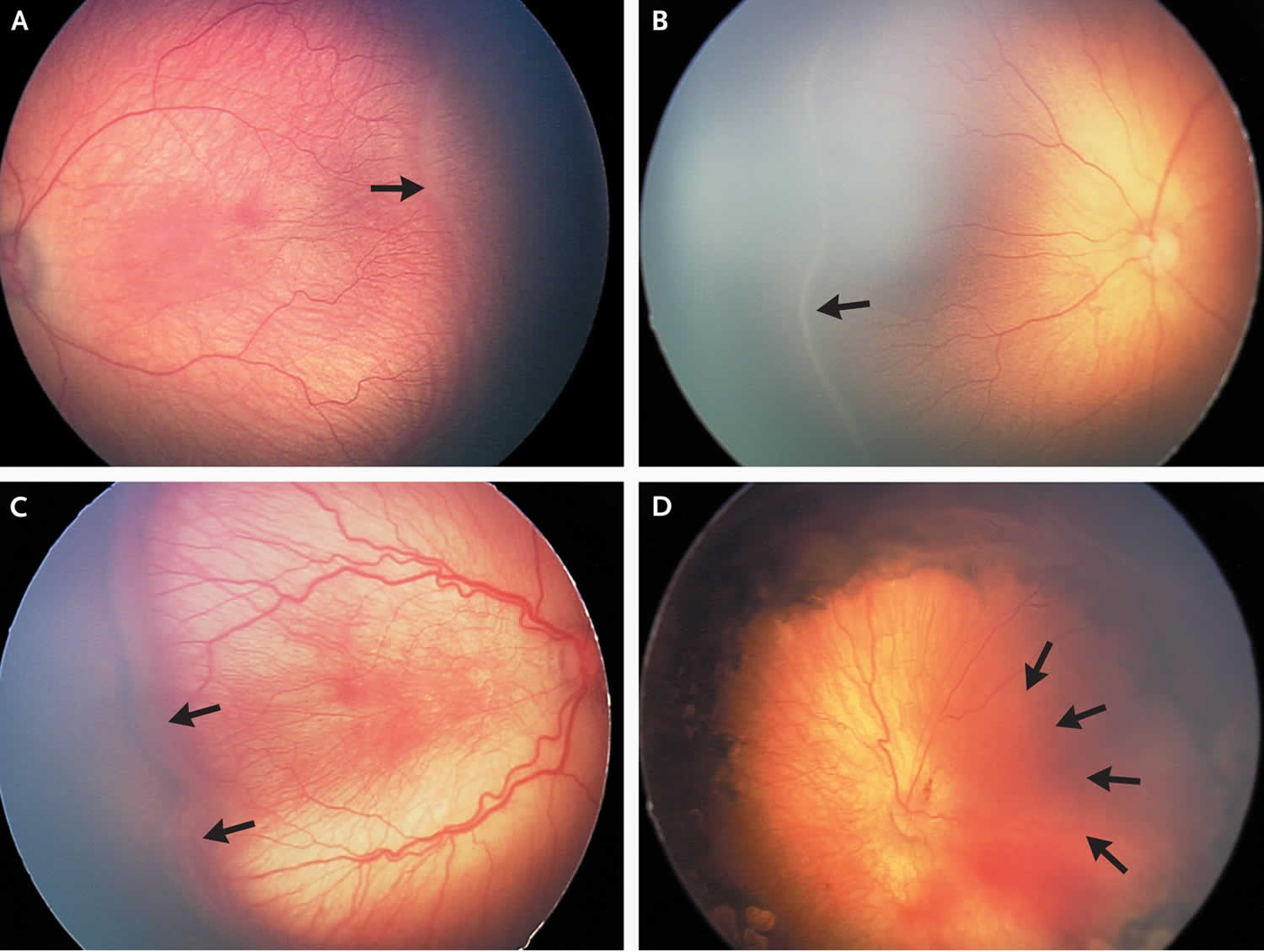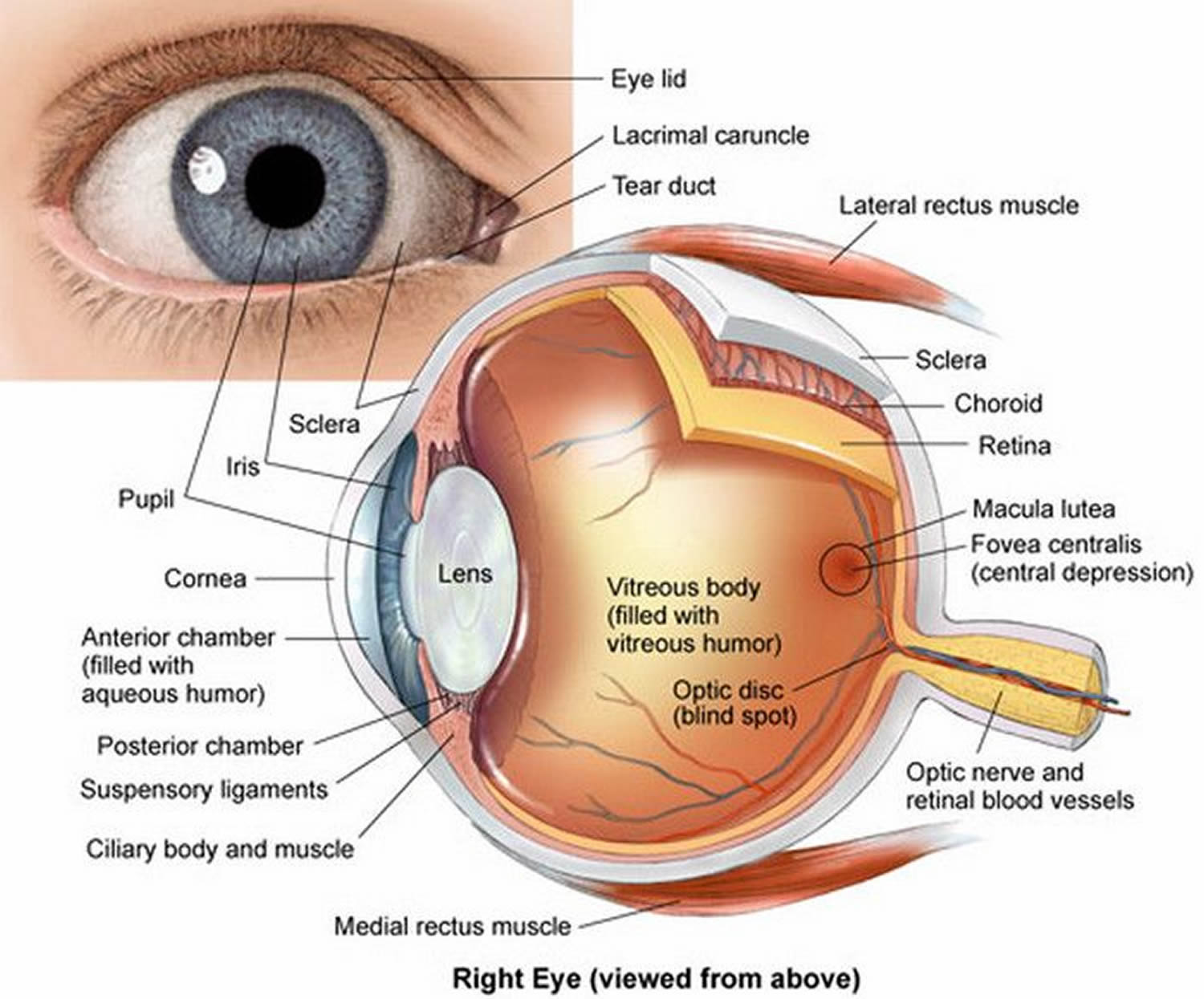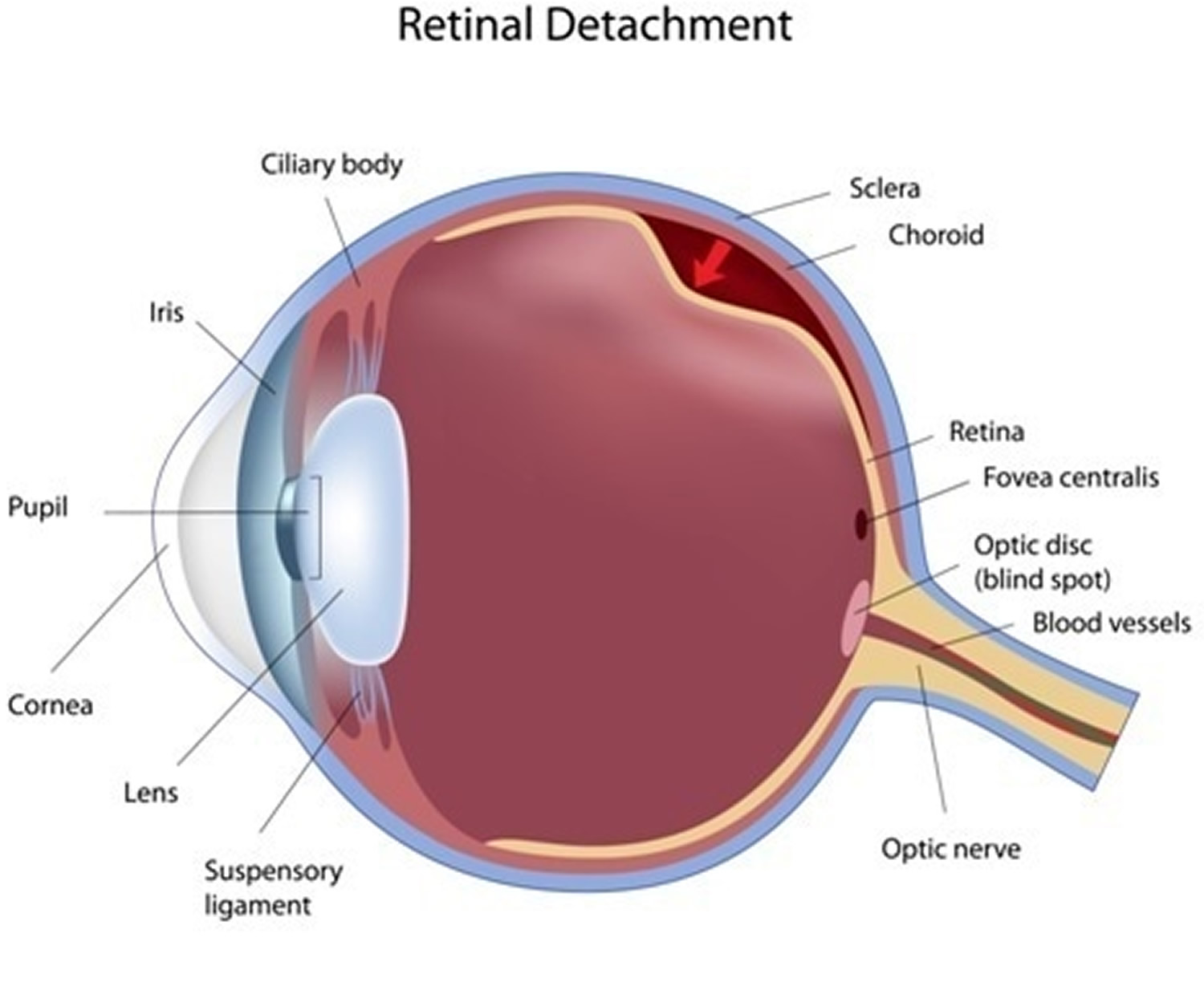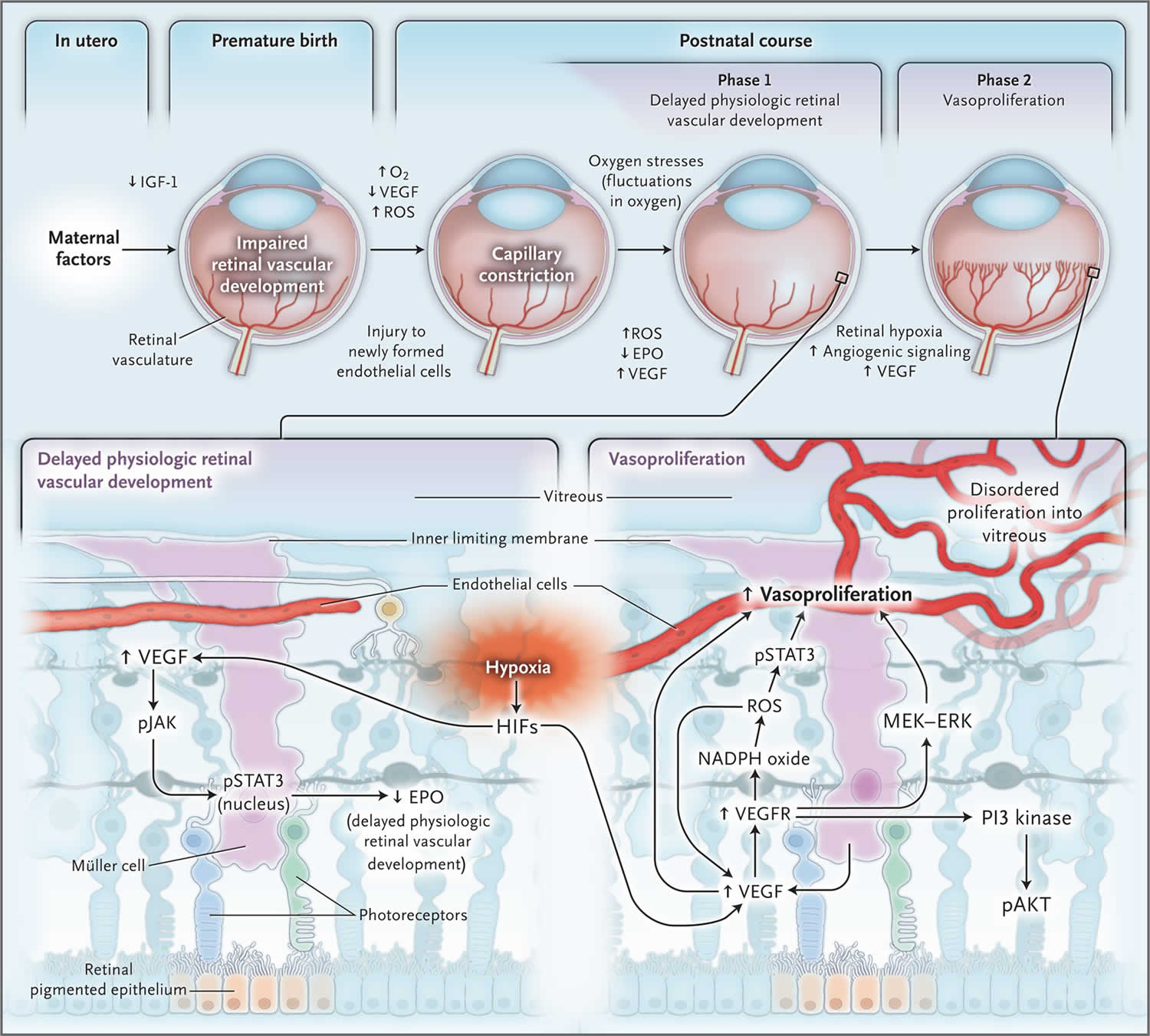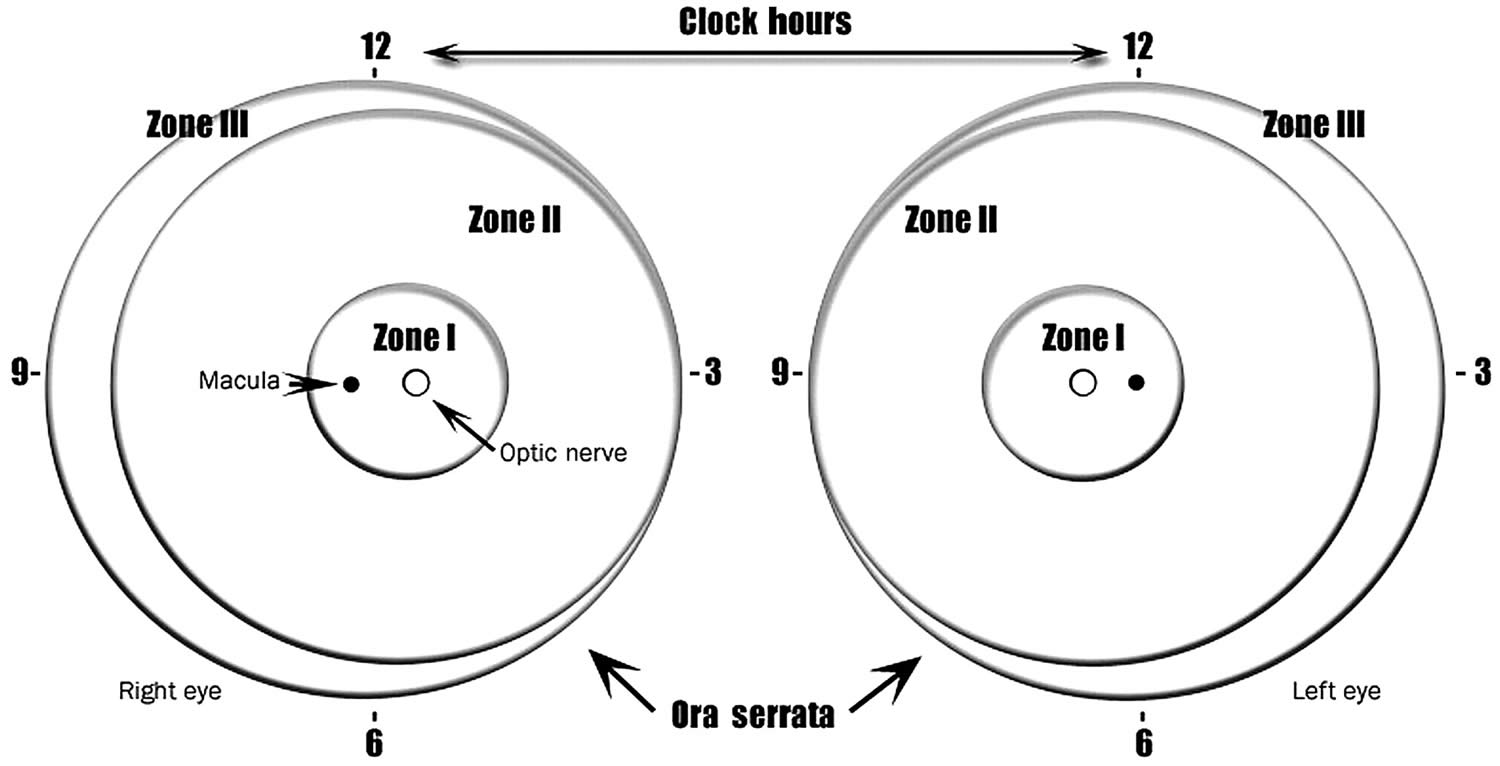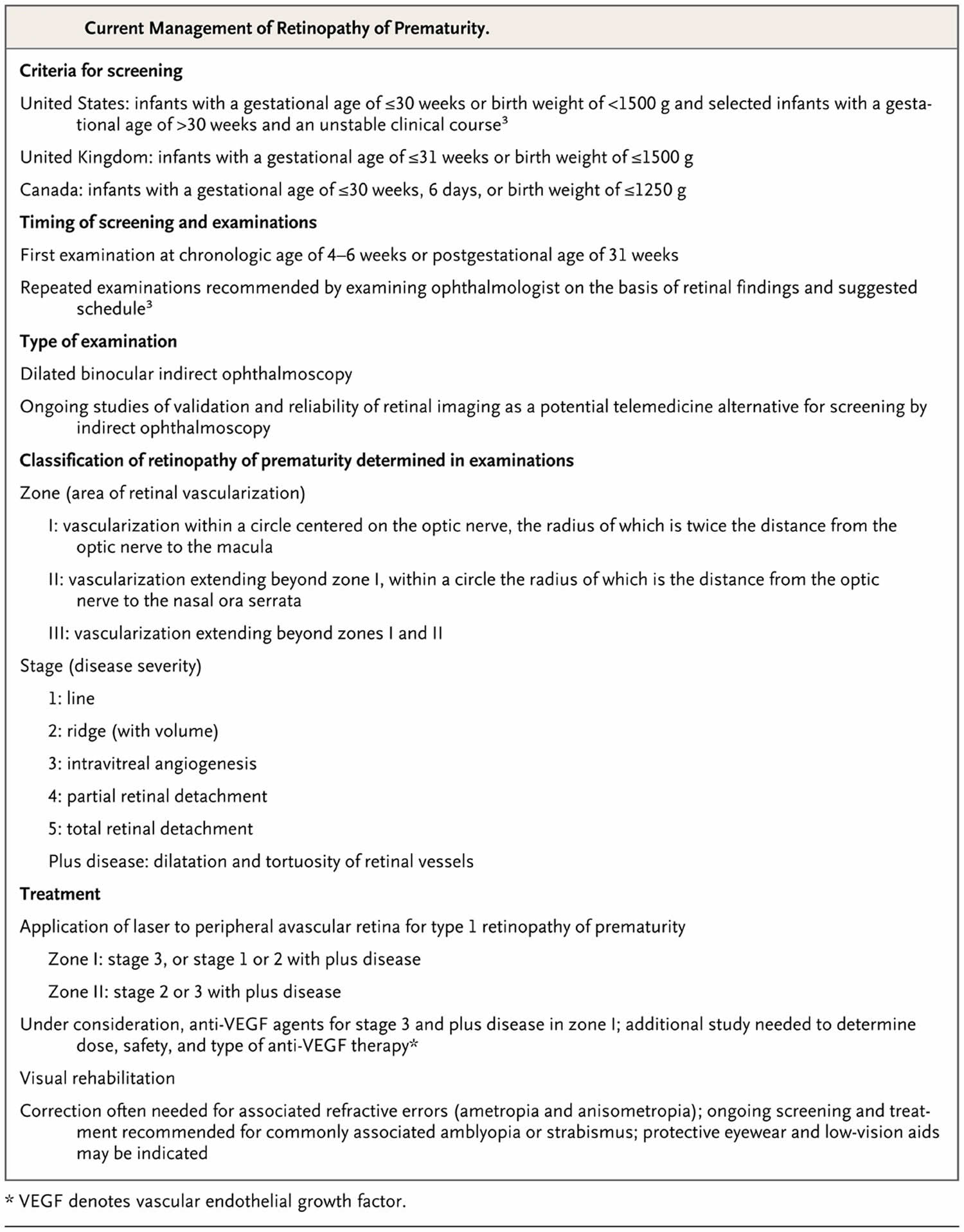Contents
Retinopathy of prematurity
Retinopathy of prematurity (ROP) is an eye disorder caused by abnormal disorganized blood vessels growth in the light sensitive part of the eyes (retina) of premature infants, which may lead to scarring, retinal detachment and blindness 1). ROP generally affects infants born before week 31 of pregnancy and weighing 2.75 pounds (about 1,250 grams) or less at birth. In most cases, ROP resolves without treatment, causing no damage. Advanced retinopathy of prematurity, however, can cause permanent vision problems or blindness.
In retinopathy of prematurity, blood vessels swell and overgrow in the light-sensitive layer of nerves in the retina at the back of the eye. When the condition is advanced, the abnormal retinal vessels extend into the jellylike substance (vitreous) that fills the center of the eye. Bleeding from these vessels may scar the retina and stress its attachment to the back of the eye, causing partial or complete retinal detachment and potential blindness.
Despite advances in diagnosis and treatment, as medicine and technology advances and premature infants are surviving at earlier gestational ages, ROP continues to be a significant problem. The incidence of premature births is increasing throughout the world, and with it, retinopathy of prematurity is now appearing in countries with the technology to save preterm infants. Thus, retinopathy of prematurity has become a leading cause of childhood blindness worldwide 2).
Figure 1. Structure of the human eye
Figure 2. The retina (inside human eye) – the retina is the section of the eye that processes light signals and converts them to nerve impulses for processing in the brain.
Figure 3. Retinopathy of prematurity
Footnote: Stages of Retinopathy of Prematurity in Zone II in Preterm Infants. Panel A shows a line between the vascularized and avascularized retina (stage 1). Panel B shows a ridge between the vascularized and avascularized retina (stage 2). Panel C shows a thickened ridge with aberrant intravitreal angiogenesis (stage 3). Panel D shows partial retinal detachment (stage 4), which is most evident at the right side of the image where the underlying choroidal vascular detail is out of focus.
[Source 3) ]Figure 4. Retinal detachment
Why do premature babies get ROP?
Scientists do not understand why some premature babies develop ROP and others do not. Much research continues to be done to solve this mystery. Serious ROP is very rarely seen in babies weighing more than 1,250 grams at birth. Many years ago ROP was more common and that was linked to excessive use of oxygen. Now the supply of oxygen to premature babies is very closely monitored and the amount of oxygen given to your baby is very carefully calculated and controlled. As a result ROP is less common but it still occurs. It is well known that the sicker and smaller a baby is the more likely it is that ROP will develop.
How will I know if my baby is getting ROP?
Doctors cannot predict which babies will develop ROP. All babies weighing less than 1250 grams at birth will need to have regular eye examinations after their gestational age reaches 30 to 31 weeks. These examinations are undertaken by a medical eye specialist known as an ophthalmologist. To look at the back of a baby’s eyes the pupil (black circle in the middle of the coloured part at the front of the eye) needs to be dilated. Eye drops are used to dilate the pupils. The examination only takes a couple of minutes. Your baby may be minimally upset by these examinations and will settle very quickly once the eyes have been checked.
What is the risk of my baby developing ROP that needs treatment?
The following table gives results for babies screened for ROP at the neonatal nursery of the Royal Women’s Hospital, Melbourne, Australia between July 1992 and June 2002. At the Royal Women’s, Melbourne only about 5 % of babies checked for ROP actually need treatment. These results will vary from nursery to nursery and from time to time and are only intended to be a guide to give some idea of the possibility of babies of certain birth weights needing treatment. It is clear form this table that most premature infants do not develop ROP severe enough to warrant treatment.
Low birth weight and prematurity are strongly associated with an increased risk of retinopathy of prematurity 4). In the Early Treatment for Retinopathy of Prematurity study, the disorder developed in 68% of premature infants born in the United States and weighing less than 1251 g; among infants with the disorder, severe retinopathy of prematurity developed in almost 37% 5).
Table 1. Risk of premature baby developing ROP
| Birth weight | Number of Babies Screened | Number of babies with ROP
That needed treatment (%) |
| > 1250 g | 245 | 0 |
| 1000 -1250 g | 489 | 4 (0.8%) |
| 750 – 999 g | 425 | 15 (3.3%) |
| 500 – 749 g | 207 | 33 (16%) |
| < 500 g | 20 | 5 (25%) |
If my baby has ROP, what happens?
In most babies ROP is mild and over a period of weeks the ROP gradually disappears. The ophthalmologist will check your baby’s eyes every one or two weeks and you will be told the result of each examination.
Can ROP be treated?
Yes, but remember very few babies develop ROP that is bad enough to need treatment. Mild ROP does not need treatment as it almost always goes away by itself. If your baby needs treatment this is called threshold disease (severe stage three ROP). If your baby develops threshold ROP treatment options will be discussed with you. The treatment is generally done with laser and in 90% of babies needing treatment the ROP disappears and sight is preserved.
If your baby may need treatment more information will be given to you and you can discuss the situation with the paediatricians and ophthalmologist caring for your baby.
Will my baby need to have eye checks after leaving hospital?
It is recommended that all babies who are small enough to have their eyes checked while in hospital should be offered an eye examination at one year of age. A small number of these children are found to have turned eyes or need glasses for clearer vision, even if they did not have any ROP while in hospital. It is strongly recommended that you make sure your baby has an eye examination at about one year of age. Depending on the finding at this check-up further eye checks may be needed. See follow-up under treatment below.
Retinopathy of prematurity causes
Retinopathy of prematurity occurs in premature infants who are born before the retinal vessels complete their normal growth. The eye starts to develop at 16 weeks gestation, when the blood vessels of the retina begin to form at the optic nerve. The blood vessels gradually grow outwards towards the edge of the developing retina, supplying oxygen and nutrients. During the last 12 weeks of pregnancy the eye develops rapidly. When an infant is born full term, the retinal blood vessel growth is mostly complete. When an infant is born prematurely (those born < 31 weeks gestation or < 1250g are thought to be the most at risk), the blood vessels have not reached the edges of the retina. Normal vessel growth may stop and the periphery of the retina may not get enough oxygen and nutrients. It is believed that the periphery then sends out signals by various mediators, such as Vascular Endothelial Growth Factor (VEGF) to other areas of the retina for nourishment. As a result of this, new blood vessels begin to grow. These new blood vessels are fragile and weak and can bleed leading to retinal scarring. If the scarring shrinks, it can pull on the retina, causing it to detach. Retinal detachment is the main cause of visual impairment and blindness in premature neonates.
Local ischemia plays a role, just as in other proliferative retinopathies like diabetic retinopathy and sickle cell retinopathy 6). Its incidence varies inversely with birth weight and gestational age. Oxygen has long been known to have a role in the disease process. Excessive oxygen can cause vaso-obliteration in the immature retina. Studies have shown that keeping the oxygen saturation at a lower level from birth can reduce the rate of advanced retinopathy of prematurity 7).
In utero, the fetus is in a hypoxic state in contrast to after birth. When infants are born prematurely, the growth of retinal vessels is stimulated by vascular endothelial growth factor (VEGF). However if the immature retina is exposed to ongoing hyperoxia, the vessels will stop growing. Over time, the avascular retina becomes ischemic and stimulates VEGF in some cases leading to arterial venous shunts and neovascularization.
In histological studies of infants with ROP, the earliest lesions seen in acute phase were arteriovenous shunts. Other lesions include neovascularization that may penetrate the vitreous, microvascular changes including tufting, and obliteration of capillaries around arteries and veins 8).
Figure 5. Revised Two-Phase Hypothesis of Retinopathy of Prematurity
Footnotes: In retinopathy of prematurity, there is initially delayed physiologic retinal vascular development, resulting in a peripheral avascular area of the retina (phase 1). Later, vasoproliferation in the form of intravitreal angiogenesis can occur at the junction of avascularized and vascularized retina (phase 2). As shown in the lower panel, increased vascular endothelial growth factor (VEGF) induced by hypoxia delays physiologic retinal vascular development by interfering with ordered vascular development; decreased VEGF in high oxygen also delays physiologic retinal vascular development by reducing developmental angiogenesis.
Abbreviations: EPO = erythropoietin, ERK = extracellular signal-regulated kinase, HIF = hypoxia-inducible factor, IGF-1 = insulin-like growth factor 1, MEK = mitogen-activated protein–ERK, O2 = oxygen, pAKT = phosphorylated protein kinase B, PI3 = phosphatidylinositol 3, pJAK = phosphorylated Janus kinase, pSTAT3 = phosphorylated signal transducer and activator of transcription 3, ROS = reactive oxygen species, and VEGFR vascular endothelial growth factor receptor.
[Source 9) ]Risk factors for developing retinopathy of prematurity
Key risk factors for retinopathy of prematurity include:
- Low birthweight
- Low gestational age
- Extended supplemental oxygen, although the exact role is not fully understood.
High levels of oxygen given to preterm neonates used to be an important risk factor but with newer technologies and monitoring of oxygen levels, this risk has diminished.
Suggested risk factors
- Intraventricular hemorrhage, resuscitation at birth, respiratory distress syndrome and prolonged ventilation, sepsis, white race, anemia and blood transfusions, multiple infections and multiple births 10).
Retinopathy of prematurity prevention
Screenings of infants at risk with appropriate timing of eye exams and follow up is essential in identifying infants in need of treatment 11). It is important to recognize that screening recommendations may vary by location. The text and table below summarizes the current recommendations for the United States 12).
The following infants should be screened for ROP:
- All neonates born < 1250 grams, regardless of gestation.
- All neonates born < 31 weeks gestation, regardless of weight.
- Neonates will be screened at 4 weeks of age but no earlier than 31 weeks corrected gestational age.
- Neonates greater than 31 weeks gestation, born > 1250g, with additional medical concerns, will be screened at the discretion of the consultant and require a special consultation request.
- 1500 grams < birthweight < 2000g grams or gestational age > 30 weeks who are believed by their pediatrician or neonatologist to be at risk for ROP (e.g. history of hypotension requiring inotropic support, received supplemental oxygen for more than a few days or without saturation monitoring
Infants should be screened “by an ophthalmologist who is experienced in the examination of preterm infants for ROP using a binocular indirect ophthalmoscope” 13).
Table 2: Recommended timing of first eye exam based on gestational age in the United States
| Gestational Age at Birth | Postmenstrual age (PMA) (weeks) | Chronologic (weeks) |
|---|---|---|
| 22 weeks | 31 | 9, consider earlier screening per clinical judgment |
| 23 weeks | 31 | 8, consider earlier screening per clinical judgment |
| 24 weeks | 31 | 7 |
| 25 weeks | 31 | 6 |
| 26 weeks | 31 | 5 |
| 27 weeks | 31 | 4 |
| 28 weeks | 32 | 4 |
| 29 weeks | 33 | 4 |
| 30 weeks | 34 | 4 |
| >30 weeks with high risk factors | – | 4 |
Retinopathy of prematurity complications
The most feared complication in ROP is retinal detachment or macular folds. There are a number of other complications related to this disease that can effect visual development. Myopia is a common finding in premature infants with our without ROP. Infants with regressed ROP also have an increased incidence of strabismus, amblyopia, and anisometropia.
Retinopathy of prematurity diagnosis
Ophthalmologists with adequate knowledge of ROP should perform retinal exams in preterm infants. The initial exam should be based on the infant’s age (see Table 1).
Following pupillary dilation using eye drops, the retina is examined using an indirect ophthalmoscope. The peripheral portions of the retina are pushed into view using scleral depression. Either separate sterile equipment or appropriate cleaning protocols should be used to avoid possible cross-contamination by infectious agents between infants.
Caution: When using dilation drops, be aware of possible adverse effects to the cardiorespiratory and gastrointestinal system of the infant.
The International Committee for Classification of Retinopathy of Prematurity developed a diagnostic classification in 1984, and since has been further refined 15). ROP is defined by location (Zone), severity (stage) and vascular characteristics in the posterior pole (normal, pre-plus or plus disease) 16).
Figure 6. Retinopathy of prematurity diagnosis
Footnote: Scheme of retina of the right and left eyes showing zone borders and clock hours used to describe the location and extent of retinopathy of prematurity. Diagrammatic representation of the potential total area of the premature retina, with zone I (the most posterior) symmetrically surrounding the optic nerve head (the earliest to develop). A larger retinal area is present temporally (laterally) than nasally (medially) (zone III). Only zones I and II are present nasally. The retinal changes are usually recorded on a diagram such as this.
[Source 17) ]Retinopathy of prematurity location (Zone)
For the purpose of defining the location, three concentric zones were defined. Since retinal vascular development proceeds from the optic nerve to the ora serrata, the zones are centered on the optic disc rather than the macula. Zone is based on the most posterior zone (as the retina may be vascularized to different extents in different regions of the retina, i.e. nasal vs temporal vs superior vs inferior).
- Zone I: The area defined by a circle centered on optic nerve, the radius of which extends from the center of the optic disc to twice the distance from the center of the optic disc to the center of the macula.
- Zone II: The area extending centrifugally from the edge of zone I to a circle with a radius equal to the distance from the center of the optic disc to the nasal ora serrata.
- Zone III: The residual temporal crescent of retina anterior to zone II. By convention, zones II and III are considered to be mutually exclusive.
Retinopathy of prematurity stages (Disease Severity)
Prior to the development of retinopathy of prematurity in the premature infant, vascularization of the retina is incomplete or “immature” (Stage 0).
- Stage 1 Demarcation Line: This line is thin and flat (in the retina plane) but definite structure that separates the avascular retina anteriorly from the vascularized retina posteriorly.
- Stage 2 Ridge: The ridge arises from the demarcation line and has height and width, which extends above the plane of the retina. The ridge may change from white to pink and vessels may leave the plane of the retina posterior to the ridge to enter it. Small isolated tufts of neovascular tissue lying on the surface of the retina, commonly called “popcorn” may be seen posterior to this ridge structure and do not constitute the degree of fibrovascular growth that is a necessary condition for stage 3.
- Stage 3 Extraretinal Fibrovascular Proliferation: Neovascularization extends from the ridge into the vitreous. This extraretinal proliferating tissue is continuous with the posterior aspect of the ridge, causing a ragged appearance as the proliferation becomes more extensive.
- Stage 4 Partial Retinal Detachment: Stage 4, in the initial classification was the final stage and initially known as the cicatricial phase 18). It was later divided into extrafoveal (stage 4A) and foveal (stage 4B) partial retinal detachments. Stage 4 retinal detachments are generally concave and most are circumferentially oriented. Retinal detachments usually begin at the point of fibrovascular attachment to the vascularized retina and the extent of detachment depends on the amount of neovascularization present 19).
- Stage 4A – Partial retinal detachment that does not involve the fovea.
- Stage 4B – Partial retinal detachment that involves the fovea.
- Stage 5 Total Retinal Detachment: Retinal detachments are generally tractional and usually funnel shaped. The configuration of the funnel itself is used for subdivision of this stage depending if the anterior and posterior portions are open or narrowed 20).
- Plus Disease: Relates to the increased venous dilatation and arteriolar tortuosity of the posterior retinal vessels. Plus disease may also include iris vascular engorgement, poor pupillary dilation (rigid pupil) and vitreous haze.
- Pre-Plus Disease: Relates to vascular abnormalities of the posterior pole that are insufficient for the diagnosis of plus disease, but in general, it is considered to be less than 2 quadrants of plus disease.
More than one stage may be present in the same eye, staging for the eye as a whole is determined by the most severe stage present. Most infants who develop ROP will have stage 1 or 2, but a small number will worsen. Sometimes ROP can worsen very rapidly which can destroy vision.
Extent
The extent of disease is recorded as hours of the clock or as 30° sectors. As the observer looks at each eye, the 3-o’clock position is to the right and nasal in the right eye and temporal in the left eye, and the 9-o’clock position is to the left and temporal in the right eye and nasal in the left eye 21).
Vascular characteristics in the posterior pole (normal, pre-plus or plus disease)
Plus disease
Additional signs of increased venous dilatation and arteriolar tortuosity of the posterior retinal vessels which can increase in severity to include iris vascular engorgement, poor pupillary dilatation, and vitreous haze was referred to as plus disease in the original classification 22). Subsequent clinical trials have used a “standard” photograph to define the minimum amount of vascular dilatation AND tortuosity that must be present in at least 2 quadrants that are required to make the diagnosis of plus disease 23).
Pre-Plus disease
There is a spectrum of abnormal dilatation and tortuosity of which Plus disease is the severe form. Pre-plus disease was later described as vascular abnormalities of the posterior pole that are insufficient for the diagnosis of plus disease but that demonstrate more arterial tortuosity AND more venous dilatation than normal 24).
Aggressive Posterior ROP (AP-ROP)
An uncommon, rapidly progressing, severe form of ROP is designated AP-ROP was later added to the classification 25). Characteristic features of this type of ROP are a posterior location, plus disease, and the ill-defined nature of the retinopathy, which usually progresses to stage 5 if untreated. This rapidly progressing has also been referred to as “type II ROP” and “Rush disease”.
Retinopathy of prematurity differential diagnosis
- Familal Exudative Vitreoretinopathy is a genetic disorder that appears similar to ROP but occurs in full-term infants.
- Persistent Fetal Vascular can cause a traction retinal detachment difficult to differentiate but typically unilateral and does not have a correlation to prematurity.
Retinopathy of prematurity treatment
How ROP is treated depends on its severity. Some of the treatments have side effects of their own. Newer research has shown promise in treating advanced cases of retinopathy of prematurity with a combination of traditional therapy and drugs.
The treatment for ROP accepted to be safe and effective was cryotherapy to the avascular retina as designated by the CRYO- ROP study in 1986 26). This produced a reduction in unfavorable outcomes in eyes with threshold ROP 27). Subsequently, argon and diode lasers have been used similarly to treat the avascular retina to reduce unfavorable outcomes. The laser units are preferred because they are more portable and better tolerated by patients 28). Currently ROP treatment guidelines are based on the Early Treatment of Retinopathy of Prematurity Study 29).
Cryotherapy treatment is currently recommended for the following (defined as “type 1” ROP):
- Zone I: any stage ROP with plus disease
- Zone I: stage 3 ROP without plus disease
- Zone II: stage 2 or 3 ROP with plus disease
- Eyes meeting these criteria should be treated as soon as possible, at least within 72 hours.
The number of clock hours of disease is no longer the determining factor for treatment.
Anti-VEGF treatment has shown promise (compared to conventional laser therapy) for treatment of stage 3 ROP with plus disease in Zone I (not Zone II) 30). Anti-VEGF treatments are NOT currently approved by the US Food and Drug Administration (FDA) for the treatment of ROP and the optimal dose, safety profile, and follow up schedule following treatment are still under investigation.
Follow-up is recommended in 3-7 days following laser photocoagulation or anti-VEGF injection 31). Surgically treated eyes must be watched carefully for regression. Very late recurrences of proliferative ROP have been reported following anti-VEGF therapy. Despite treatment, some eyes will progress to retinal detachment. In the CRYO-ROP study, approximately 30% of eyes progressed to posterior pole macular fold or retinal detachment 32). These eyes may need vitreoretinal surgery. At the reported 15-year outcome from the CRYO-ROP study, “between 10 and 15 years of age, new retinal folds, detachments, or obscuring of the view of the posterior pole occurred in 4.5% of treated and 7.7% of control eyes” 33). Thus, they recommended that eyes that experience threshold should have long-term, regular follow up.
Table 3. Current management of retinopathy of prematurity
[Source 34) ]Laser therapy
The standard treatment for advanced retinopathy of prematurity, laser therapy burns away the area around the edge of the retina, which has no normal blood vessels. This procedure typically saves sight in the main part of the visual field, but at the cost of side (peripheral) vision. Laser surgery also requires general anesthesia, which may be risky for preterm infants.
Cryotherapy
This was the first treatment for retinopathy of prematurity. Cryotherapy uses an instrument to freeze a specific part of the eye that extends beyond the edges of the retina. It is used rarely now because outcomes from laser therapy are generally better. As with laser therapy, the treatment destroys some peripheral vision and must be done under general anesthesia.
Medications
Research on anti-vascular endothelial growth factor (anti-VEGF) drugs to treat retinopathy of prematurity is ongoing. Anti-VEGF drugs work by blocking the overgrowth of blood vessels in the retina. The medication is injected into the eye while the infant is under a brief general anesthesia. Although no drugs have received US Food and Drug Administration (FDA) approval to treat retinopathy of prematurity specifically, some medications approved for other uses are being explored as alternatives to laser therapy, or to be used in conjunction with it.
Bevacizumab (Avastin) has FDA approval for treating colon cancer, but is also widely used to curb the overgrowth of retinal blood vessels in two serious adult eye diseases, wet macular degeneration and advanced diabetic retinopathy. The drug has shown some promise in treating ROP in initial research and may be an option for preterm infants at highest risk of vision loss. Other FDA-approved drugs for eye injections, such as ranibizumab (Lucentis), aflibercept (Eylea) and pegaptanib (Macugen), also are being used and studied as retinopathy of prematurity treatments.
Combination treatment
Studies have shown that anti-VEGF drugs may improve outcomes when used in conjunction with laser therapy.
More research is needed into the timing of anti-VEGF drugs for a preterm infant, the optimal dose of the medication and how long its effects last. Doctors don’t yet know the long-term impact of using these drugs in preterm infants. Some concern exists that the drugs might slow down the formation of normal blood vessels in other parts of a baby’s body.
Follow up
Follow up recommendations were updated in 2019 by the American Academy of Pediatrics and depend on the location and stage 35).
The timing of follow up examinations 36) are based on retinal exam findings as classified by the International Classification of Retinopathy of Prematurity revisited 37).
- Recommended follow up in 1 week or less:
- Zone I: stage 0 (immature vascularization), 1, or 2 ROP
- Posterior Zone II: immature vascularization
- Suspected presence of Aggressive Posterior ROP (AP-ROP)
- Recommended follow up in 1-2 weeks:
- Zone I: unequivocally regressing ROP
- Posterior Zone II: immature vascularization
- Zone II: stage 2 ROP
- Recommended follow up in 2 weeks:
- Zone II: Stage 0 (immature vascularization) or 1, or unequivocally regressing ROP
- Recommended follow up in 2-3 weeks:
- Zone II: regressing ROP
- Zone III: stage 1 or 2 ROP
Termination of acute retinal screening examinations based on age and retinal finding. Examinations can be stopped when:
- Retina is fully vascularized
- Zone III retinal vascularization without previous ROP in Zone I or II (may need a confirmatory exam if PMA <35 weeks)
- Postmenstrual age (PMA) = 45 weeks and no type 2 ROP (“prethreshold disease”) (i.e. stage 3 ROP in zone II, any ROP in zone I) or worse ROP
- If previously treated with anti-VEGF (vascular endothelial growth factor) injection, follow until at least postmenstrual age (PMA) =65 weeks (infant needs close follow up during time of highest risk for disease reactivation postmenstrual age (PMA): 45-55 weeks)
- ROP has fully regressed (ensure there is no abnormal vascular tissue present that can reactivate and progress)
Long-term follow up:
After termination of acute retinal screening. Prematurely-born infants should be seen within 4-6 months after discharge from the neonatal intensive care unit (NICU) because they are at increased risk for developing strabismus, amblyopia, high refractive error, cataract, and glaucoma.
Retinopathy of prematurity prognosis
Infants with ROP are also at increased risk of developing other eye problems later in life such as retinal detachment, myopia, strabismus, and amblyopia. In many cases these problems can be treated or controlled. If ROP progresses leading to retinal detachment, the outcome is visually devastating. The CRYO-ROP study showed that at the 15-year follow-up treatment reduces the risk of unfavorable outcome from 52% to 30% 38). The same study showed improved outcomes in the treated group for visual acuity at the 3-year, 10-year, and 15-year follow up.
References [ + ]
